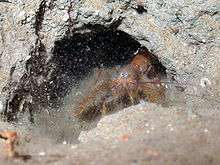Furry lobster
Furry lobsters (sometimes called coral lobsters) are small decapod crustaceans, closely related to the slipper lobsters and spiny lobsters.[1] The antennae are not as enlarged as in spiny and slipper lobsters, and the body is covered in short hairs, hence the name furry lobster. Although previously considered a family in their own right (Synaxidae Spence Bate, 1881), the furry lobsters were subsumed into the family Palinuridae in 1990,[2] and molecular phylogenies support the inclusion of the furry lobsters in the family Palinuridae.[1]
| Furry lobsters | |
|---|---|
 | |
| Palinurellus gundlachi | |
| Scientific classification | |
| Kingdom: | |
| Phylum: | |
| Subphylum: | |
| Class: | |
| Order: | |
| Infraorder: | |
| Family: | Palinuridae (or Synaxidae) |
| Genera and species | |
| |
Taxonomy
There are two genera, with three species between them:[3]
- Palinurellus gundlachi Von Martens, 1878 – Caribbean furry lobster, found in the Caribbean Sea and the Atlantic coast of South America; named for Juan Gundlach
- Palinurellus wieneckii (De Man, 1881) – mole lobster, with an Indo-Pacific distribution
- Palibythus magnificus P. J. F. Davie, 1990 – musical furry lobster, from the South Pacific (originally described from Samoa)
gollark: Oh hey remy.
gollark: r!play bee noises 1 hour
gollark: q!play bee noises 1 hour
gollark: 2
gollark: p!play bee noises 1 hour
References
- Ferran Palero; Keith A. Crandall; Pere Abelló; Enrique Macpherson; Marta Pascual (2009). "Phylogenetic relationships between spiny, slipper and coral lobsters (Crustacea, Decapoda, Achelata)". Molecular Phylogenetics and Evolution. 50 (1): 152–162. doi:10.1016/j.ympev.2008.10.003. PMID 18957325.
- Joel W. Martin; George E. Davis (2001). An Updated Classification of the Recent Crustacea (PDF). Natural History Museum of Los Angeles County. pp. 1–132.
- "Synaxidae Bate, 1881". Integrated Taxonomic Information System. Retrieved February 15, 2011.
This article is issued from Wikipedia. The text is licensed under Creative Commons - Attribution - Sharealike. Additional terms may apply for the media files.